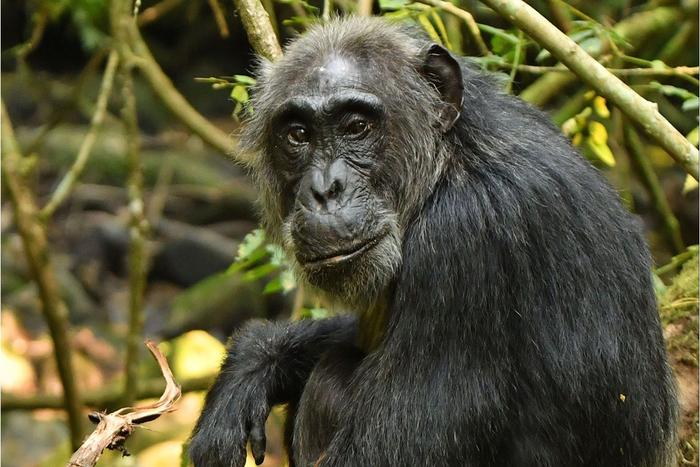Journal Article

Photo: The Ngogo Chimpanzee Project
A team of researchers studying the Ngogo community of wild chimpanzees in western Uganda’s Kibale National Park for two decades has published a report in Science showing that females in this population can experience menopause and postreproductive survival. This research was supported in part by The Leakey Foundation.
Prior to the study, these traits had only been found among mammals in a few species of toothed whales, and among primates — only in humans. These new demographic and physiological data can help researchers better understand why menopause and post-fertile survival occur in nature, and how it evolved in the human species.
“In societies around the world, women past their childbearing years play important roles, both economically and as wise advisors and caregivers,” said Brian Wood, a UCLA associate professor of anthropology. “How this life history evolved in humans is a fascinating yet challenging puzzle.”
Wood, first author of the paper, worked closely with Kevin Langergraber from Arizona State University, Jacob Negrey of University of Arizona, and Ngogo Chimpanzee Project founders and co-directors John Mitani and David Watts.
“The (study) results show that under certain ecological conditions, menopause and post-fertile survival can emerge within a social system that’s quite unlike our own and includes no grandparental support,” Wood said, referring to the grandmother hypothesis.
That hypothesis, which has been used to explain the existence of human postmenopausal survival, proposes that females in their postreproductive years may be able to pass on more of their genes by helping to raise the birth rates of their own children or by caring directly for grandchildren, thereby increasing grandchildren’s odds of survival. And indeed, several studies of human grandmothers have found these positive effects. But chimpanzees have very different living arrangements than humans. Older female chimpanzees typically do not live near their daughters or provide care for grandchildren, yet females at Ngogo often live past their childbearing years.
While substantial postreproductive life spans have not previously been observed in other long-term studies of wild chimpanzees, they have sometimes been seen in chimpanzees and other primates in captivity, who receive good nutrition and medical care. This raises the possibility that the postreproductive life spans of female Ngogo chimpanzees may be a temporary response to unusually favorable ecological conditions, as this population enjoys a stable and abundant food supply and low levels of predation. Another possibility, however, is that postreproductive life spans are actually an evolved, species-typical trait in chimpanzees but have not been observed in other chimpanzee populations because of the recent negative impacts of humans.
“Chimpanzees are extremely susceptible to dying from diseases that originate in humans and to which they have little natural immunity,” Langergraber said. “Chimpanzee researchers, including us at Ngogo, have learned over the years how devastating these disease outbreaks can be to chimpanzee populations, and how to reduce their chances of happening.”

An extraordinary effort
The team of researchers examined mortality and fertility rates of 185 female chimpanzees from demographic data collected from 1995 to 2016. They calculated the fraction of adult life spent in a postreproductive state for all the observed females and measured hormone levels in urine samples from 66 females of varying reproductive statuses and ages, ranging from 14 to 67 years.
Discovery starts with you.
Your donation sustains long-term studies like this one.
Thousands of hours of fieldwork at Ngogo were needed to collect the observations and samples needed for this study. Hormone samples were analyzed by Tobias Deschner and Melissa Emery Thompson.
“This study is the result of an extraordinary amount of effort,” Negrey said. “It’s only because our team has spent decades monitoring these chimpanzees that we can be confident some females live long after they’ve stopped reproducing. We also spent thousands of hours in the forest to collect urine samples from these chimpanzees with which to study hormonal signals of menopause.”
The researchers measured hormone levels associated with human menopause, which include increasing levels of follicle-stimulating hormone and luteinizing hormone, as well as decreasing levels of ovarian steroid hormones, including estrogens and progestins.
As with other chimpanzee populations and humans, fertility in the chimpanzees studied declined after age 30, with no births observed after age 50. The hormone data showed that the Ngogo females experienced a menopausal transition similar to that of humans, beginning around age 50.
Also like humans, it was not unusual for these female chimpanzees to live past 50. A female who reached adulthood at age 14 was postreproductive for about one-fifth of her adult life, about half as long as a human hunter-gatherer.
“We now know that menopause and post-fertile survival arise across a broader range of species and socio-ecological conditions than formerly appreciated, providing a solid basis for considering the roles that improved diets and lowered risks of predation would have played in human life history evolution,” Wood said.
The researchers say that it will also be critical to track the behavior of older chimpanzees and observe how they interact with and influence other group members.
“To allow such work, it is essential to support the long-term study of primates in the wild,” Wood said.
Key takeaways
- Female chimpanzees in Uganda’s Ngogo community experienced a menopausal transition similar to women.
- Fertility among chimpanzees studied declined after age 30, and no births were observed after age 50.
- The data can help researchers better understand why menopause and post-fertile survival occur in nature and how it evolved in the human species.
This article was created with materials provided by UCLA. Click to read the original story.
Brian M. Wood et al., Demographic and hormonal evidence for menopause in wild chimpanzees. Science382. DOI:10.1126/science.add5473

